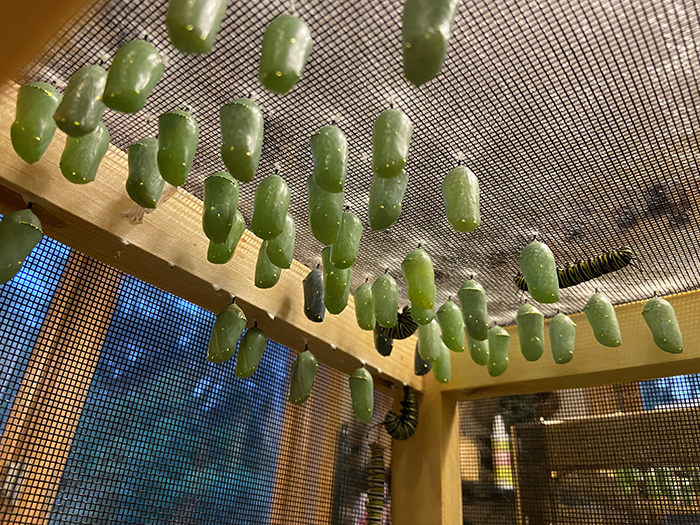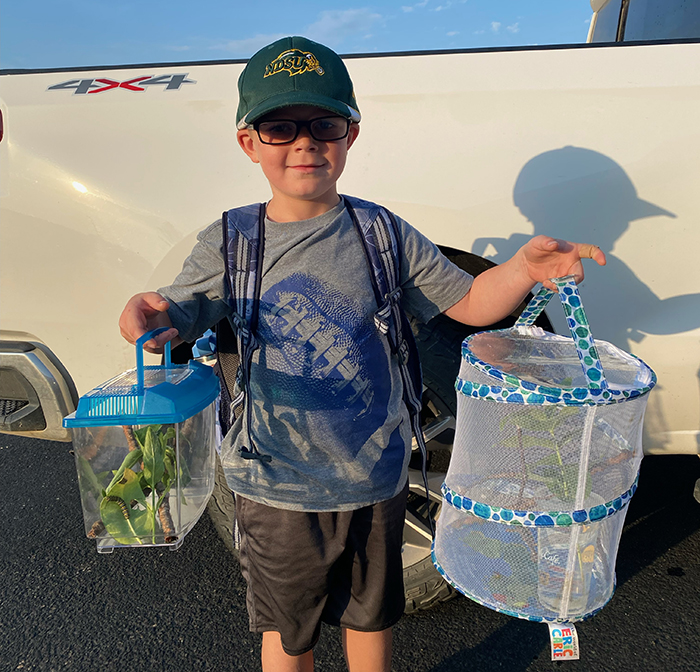Jaxon Schrupp, 7, is helping rebuild the Monarch population
News | Published on December 19, 2023 at 12:59pm EST | Author: frazeevergas
0Vergas first-grader aiming to release more than 300 next year

By Robert Williams
Editor
After spending years on the endangered species list over the past decade, migratory Monarch Butterflies have made a rebound and Jaxon Schrupp of Vergas has been making his own efforts to aid in the resurgence of the popular flying insect.

Schrupp, 7, is a first grader at Heart O’ the Lakes Elementary School in Perham and upon learning about butterflies from a friend of the family, he made raising butterflies a priority and a hobby that has encompassed the help of his entire family.
According to Science magazine, the International Union for Conservation of Nature (IUCN) has decided North America’s monarch butterfly is no longer endangered. Instead, the insect is only “vulnerable” to extinction, adding that it could lower the alarm still further, changing the listing to near threatened if an upcoming census suggests the population is stable or growing.
Jaxon also saw a big change from his first year where his hobby began late in the year to the second year when he had a full season. His numbers are growing exponentially.
“Last year, we raised 30 and this year we raised 242,” Jaxon said.
This year, Jaxon got an early start in late May.

“We just saw one Monarch flying around and he comes in with a leaf and I told him, ‘don’t be picking the milkweed.’” Jaxon’s mom Jordan said.
“I said, mommy, I picked some milkweed and she said no, it’s not time yet,” said Jaxon. “Guess what, there’s a baby caterpillar on it!”
Monarchs hatch over three stages during summer and early fall with the first two sets released laying eggs. Adult monarchs live for anywhere from 2 to 6 weeks, and females lay eggs and males mate throughout most of this period.
The Schrupps have small nurseries for eggs and larvae, which Jaxon described as, “baby, baby, baby, really baby, like just born caterpillars that we raised.”
Caterpillar eggs are miniscule and not easy to find, except Jaxon has a keen sense that aids him in finding them.
“I have good eyes,” he laughed.
The eggs are found on and under the leaves.
Jaxon scans for two key things to find the eggs.

“Munch holes and poop,” he said. “First you look for the munch holes, then you look at the ends of the leaves and then you put them in a bucket and bring them home to put them in the cage and just let them eat.”
Jaxon’s quest to find them is also to spare baby butterflies from predators.
“Under the leaves, tea flies and wasps can get them and ants like to eat the eggs,” he said.
Once the eggs are collected, Jaxon transfers them to a nursery to get them to hatch.
“We have to keep a wet, paper towel in there, otherwise they’ll die,” he said.
According to MonarchWatch.org, Monarchs usually lay a single egg on a plant, often on the bottom of a leaf near the top of the plant. It is difficult to tell just how many eggs each female lays during her life, but the average is probably from 100 to 300. The eggs hatch about four days after they are laid.
The next two weeks are the larva stage. It is during this stage that Monarchs do all of their growing. They begin life by eating their eggshell, and then move on to the plant on which they were laid.
When the caterpillar has become too large for its skin, it molts, or sheds its skin. At first, the new skin is very soft, and provides little support or protection. The new skin soon hardens and molds itself to the caterpillar, which often eats the shed skin.
“They eat it!” Jaxon said.
The Monarchs have also changed the way the Schupp family eats at their home during butterfly season. The entire setup is kept where dinner would normally be.
“On the kitchen table,” Jordan said. “He’s got three big cages on the kitchen table.”
When asked where dinner is served, “TV trays,” she laughed.
The intervals between molts are called instars. Monarchs go through five instars growing from 2 millimeters to anywhere from 25-45 millimeters.
“We have two cages and one big black cage,” said Jaxon.
The metamorphosis can fill up a cage rapidly.
“We’ve had probably 60-70 chrysalis’ at one time,” Jason said.
“We got it to where it was totally full, two cages worth,” said Jordan. “We had a system where in the two smaller cages we put what we call the big chubbies in there ready to go up. In the big black cage, we had medium-sized ones and in the nurseries were the babies.”
Mom gets the job of cleaning the pens every night and also as a support system at times.
“We’ve learned a lot, for sure,” said Jordan.
While the lifecycle of successfully bringing butterflies from egg and larva stage to full-grown is an amazing process, there were some failures and deaths which were traumatizing at first. The Schrupp family described the first year as trial and error.
A bad batch of milkweed can also create issues. Unbeknownst to Jaxon, he once received some milkweed that was tainted with herbicide.
“We learned the hard way,” said Jason.
“Some of them died,” said Jaxon. “I’m never taking milkweed from that house again.”
Even common pesticides, like those used to control mosquitoes, will kill Monarchs.
To attract more butterflies the Schrupps planted an entire garden of milkweed at their home and Jaxon is always keeping an eye peeled for more.
“He can spot milkweed from a mile away,” said Jason.
“And our uncle Patrick, he really likes Monarchs,” said Jaxon.
“Uncle Patrick” lives next door and Jaxon released Monarchs in his yard and got money from Patrick to buy more milkweed.”
Purchasing milkweed is easiest via online ordering of organic milkweed seed. The Schupps also grow it from seeds they collect. Typical milkweed found in stores or nurseries have pesticide on them and will not work for home-raising Monarchs.
“We usually go get milkweed to feed but in the process we’re looking for new ones all the time,” said Jordan.
Surprisingly, Monarchs’ love for milkweed makes them toxic to predators and milkweed can also be dangerous to humans.
“Butterflies are poisonous because they eat the milk and the milk is poisonous,” said Jaxon. “You have to be careful not to get the milkweed in your eyes because you could go blind.”
The family had a milkweed, Monarch rescue mission after a local company installed new internet lines in their yard. Prior to the arrival, the family went on a quest to find eggs. During the installation, a large patch of milkweed was run over in the process.
“We went there and found some big chubbies just laying there in the knocked over milkweed,” Jaxon said. “I was like, ‘Do you want to get squished?’”
Jaxon’s hobby has certainly become a family function for both parents and Jaxon’s big brother Jayden. Jordan has joined a butterfly group to gain more knowledge and experience. From the group, the Schrupps learned that occasionally the larger butterflies will unintentionally eat the small ones because they smell like milkweed, hence the separation in cages by size.
“And if one touches another’s antenna they get into a fight,” said Jaxon.
For Jaxon, who is a busy little guy adding flag football, baseball, basketball, and tae kwon do to his list of hobbies, Monarchs are a full-time summer job and he is constantly on the alert for more butterflies or milkweed.
“I was practicing riding my bike past the golf course and we found a little milkweed and I had a container in my pocket and we let them go in there,” he said.
“Every baseball game that Jayden plays Jaxon is gone and he probably found caterpillars at every baseball game,” said Jordan.
Jaxon has also learned about different kinds of milkweed, like marsh milkweed.
“It’s just like normal milkweed but skinnier and more pointy and it grows by swamps,” Jaxon said. “I found one at the lake one time and a big chubby ate it all up. At the doggy plunge, I found a lot too.”
The family hobby has stretched to Jaxon’s grandparents with grandma saving containers for him and grandpa pounding holes in plenty of jars.
Grandparent duties also stretch to caring for the Monarchs during Schrupp family vacations.
“Grandpa had the list; he had to make sure he wrote down if they were moms or dads,” said Jason.
Jaxon keeps track of every single Monarch and keeps a tally of them by gender.
“The dads have little dots in between their wings and the moms don’t,” he said.
Of the 272 he has released over the past two summers 127 were females and 115 males.
After hatching the butterflies have wet wings and are almost ready to be released.
“They have wet wings before they can fly,” said Jaxon. “When they’re dry, we take them out and when they’re ready to go we put them on our fingers and release them.”
The last cycle of Monarchs that are released in the fall are the butterflies that migrate south and back. The monarch is the only butterfly known to make a two-way migration as birds do.
“And those are the ones that lay eggs next year,” said Jaxon.
The most Jaxon has released in one day was a dozen.
“If they hatch in the morning and it’s warm out they can dry faster and they get all frisky and then they’re gone. If it’s rainy and cool it might take them up to a day,” Jordan said.
Jaxon has also contributed Monarchs as a school project for two different kindergarten classes in Perham after Mrs. Ogroske and Mrs. Wokasch requested some from him to use as a learning aid in their classrooms.
When asked if he has gotten any of his friends hooked on raising Monarchs, Jaxon acknowledged that he has a good setup and a lot of support at home that allows him to take over the whole kitchen table with his hobby.
“I don’t think their moms would really let them,” he said. “If they want to learn more about them they have to ask me.”
Jaxon’s goal for next year is releasing 300 or more Monarchs.
“I’m trying to break my record,” he said.

